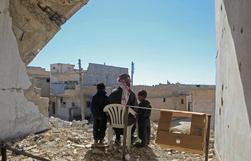From Afghanistan to Syria, cover-ups are the norm until facts damn military
 Syrian Khalil Ibrahim sits at an abandoned building in the northern town of Tadif, located about 32 kilometres (20 miles) east of Aleppo city, on Oct 7, 2021. (BAKR ALKASEM / AFP)
Syrian Khalil Ibrahim sits at an abandoned building in the northern town of Tadif, located about 32 kilometres (20 miles) east of Aleppo city, on Oct 7, 2021. (BAKR ALKASEM / AFP)
Without any warning, a warplane drops a bomb on a crowd. As those survivors able to move flee in panic, another bomb falls from the sky. The second explosion proves deadlier, killing most of those sent scattering by the first blast.
This is not a scene from a war movie, nor is it a plot in a video game. The events happened in Syria on March 18, 2019, when the US military was searching for military targets in the eastern village of Baghouz, the last Syrian stronghold of the Islamic State terror group.
A US special task force operating in Syria dropped three bombs in all on a cluster of civilians near the village, killing 70 people, mainly women and children, according to a recent New York Times investigation.
The newspaper published the results of its investigation on Saturday and said a US legal officer "flagged the strike as a possible war crime" but that "at nearly every step, the military made moves that concealed the catastrophic strike".
Drawing from confidential documents, interviews with personnel directly involved and officials with top security clearance, the newspaper found that the strike "was one of the largest civilian casualty incidents of the war against the Islamic State".
But it was never publicly acknowledged by the US military.
The strike was carried out despite the presence of civilians by the special operations unit Task Force 9 after a request from the Kurdish-led Syrian Democratic Forces. Military directives in place to protect civilians were ignored.
"The death toll was downplayed. Reports were delayed, sanitized and classified. United States-led coalition forces bulldozed the blast site. And top leaders were not notified," the report said, adding that the Pentagon's independent inspector general's probe findings were "stalled and stripped of any mention of the strike".
This disclosure cannot help but remind people of a tragedy that happened in Afghanistan not long ago, which resulted in the deaths of 10 civilians, including seven children.
Drone strike in Kabul
The US military launched a drone strike on a vehicle in Kabul, which it claimed had eliminated an "imminent" threat posed by ISIS-K, an Afghanistan-based offshoot of the Islamic State, to the Hamid Karzai International Airport. Evacuations of US service members and others were underway at the time.
In that incident on Aug 26, the military later admitted it was "a tragic mistake".
"We now assess that it is unlikely that the vehicle and those who died were associated with ISIS-K, or were a direct threat to US forces," said Kenneth McKenzie, commander of the US Central Command.
Such attacks that hurt civilians were aimed ultimately at serving the homeland security interests of the US, said Yang Nan, assistant researcher at the Institute of American Studies of the Chinese Academy of Social Sciences. "The reason for these casualties might be because the situation was not fully clear at that time," he said. "But for quite a long time, during the overseas operation, the US has been pursuing a policy of better killing hundreds of thousands than missing one."
And for these innocent casualties, Yang said, the US would find an excuse and describe them as those who "shield the terrorists".
In response to The New York Times report, the US Central Command on Sunday said the airstrike was "legitimate self-defense", "proportional" and that "appropriate steps were taken to rule out the presence of civilians".
It said that an investigation was launched after a military report found there had likely been civilian casualties. Along with 16 IS fighters determined to have died in the bombing, the investigation concluded at least four civilians were killed and eight wounded.
"We self-reported and investigated the strike according to our own evidence and take full responsibility for the unintended loss of life," said CENTCOM spokesman Captain Bill Urban.
Each bombardment was meant to be preceded by checks, sometimes lasting days or weeks.
But the report said: "Over time, some officials overseeing the air campaign began to believe that the task force was systematically circumventing the safeguards created to limit civilian deaths."
Agencies via Xinhua contributed to this story.


